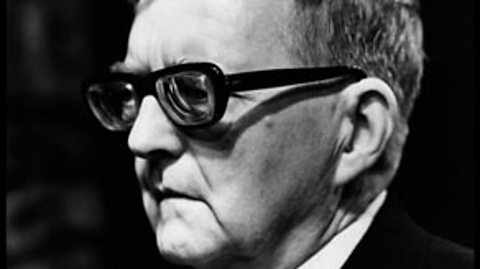Lemn Sissay investigates what it was like writing music under Stalin's oppressive regime.
Shostakovich was a 20th Century Russian composer and pianist, who spent most of his career working under the Soviet leader Joseph Stalin. After studying at music college, Shostakovich embarked on a career which would be very successful… but very complicated. In 1948, Shostakovich was accused of writing 'inappropriate' music by the Soviet government. This meant anything that had a Western influence and was seen as 'non-Russian'. After this, all Soviet composers could only write 'proletarian' music – music for the Russian masses. Shostakovich's creativity was limited by Stalin's regime.
Stalin's death in 1953 was the biggest step towards Shostakovich's restoration as a creative artist – finally he could express himself freely! This transition was marked by his 10th Symphony which was written at some point in the early 1950s, and premiered on 17 December 1953, after Stalin had died. Shostakovich said himself of the piece: "I did depict Stalin in my 10th symphony. I wrote it right after Stalin's death and no one has yet guessed what the symphony is about. It's about Stalin and the Stalin years. The second part, the scherzo, is a musical portrait of Stalin."
Listen out for: What the piece says about Stalin. Scherzo means 'joke', so while Shostakovich was pretending to write 'good, Russian music' for Stalin, he was perhaps sneakily making fun of him. Have a listen and see what it makes you think of – would you like someone to compose a piece of music like this about you?
This piece feels full of panic, terror and anger. It races towards its conclusion. The music creates the sense of a fast and incessant tempo (speed). Perhaps this reflected the panic and anxiety Shostakovich felt at the fear of being taken prisoner by Stalin.
A performance of Symphony No. 10 (2nd movement) by the 91Čȱ¬ Philharmonic Orchestra.
Dmitri Shostakovich
Shostakovich was a bit of a rebel. He was writing music in Russia during a time when there were strict rules from Stalin's government as to what the music should sound like and Shostakovich found many clever ways of getting around these rules without getting caught. His music is usually big, loud and serious and his 15 symphonies and 15 string quartets focus on the big subjects – war, life and death.
Shostakovich had his music banned by the authorities twice and became so frightened that it would happen again that he had a habit of sleeping by the door of his apartment in his coat with fully packed suitcase at his feet. If the police came to get him, he wanted to be ready to go without disturbing his family! He also kept a locked drawer full of compositions that he knew would get banned if they were ever heard. So, when the Russian leader Stalin died, Shostakovich released these compositions and the world learnt what a great composer Shostakovich really was.

MP3: Listen to or download the music
To save to your computer: PC - right-click and save, Mac - ctrl-click and save.

Lesson Plans
Download classroom lesson plans to explore Shostakovich's music.To save to your computer: PC - right-click and save, Mac - ctrl-click and save.
To enable all images to work in the Powerpoint files please save the file to your computer. To save to your computer: PC - right-click and save, Mac - ctrl-click and save.
Primary lesson plans:
Lesson plan by Rachel Leach
Suitable for:*Key Stage 2 in England and Wales
*Second Level, P5-P7 in Scotland
*Key Stage 1/Key Stage 2 in Northern Ireland
Secondary lesson plans:
Lesson plan 1 written by Chris Redmond.
Lesson plan 2 written by Ann Barkway.
Suitable for:
*Key Stage 3 in England, Wales and Northern Ireland
*Third and Fourth Level, S1-S3 in Scotland
Arrangements (original key of B minor)
These parts are in the original key of B minor so can be played with hired parts. The parts have been designed to work together to enable mixed-ability groups to perform together.
Beginner/pre-Grade 1 (original key of B minor)
- | | |
- | | |
- | |
- | | |
- | | | | |
- |
Grade 1-3 (original key of B minor)
- | | |
- | | |
- | |
- | | |
- | | | | |
- |
Grades 4-5 (original key of B minor)
- | | | |
- | | | |
- |
- | | |
- | | | |
- |
Combined score
Original instrumentation
In case you're considering using original parts together with these arrangements, you may find the composer's original instrumentation helpful:
3.3.3.3 – 4.3.3.1 – tmp+4, strings
Arrangements (transposed key of A minor)
These parts are in the transposed key of A minor. The parts have been designed to work together to enable mixed-ability groups to perform together.
Beginner/pre-Grade 1 (transposed key of A minor)
- | |
- | | |
- | |
- | | |
- | | | | |
- |
Grade 1-3 (transposed key of A minor)
- | | |
- | | |
- | |
- | | |
- | | | | |
- |
Grade 4-5 (transposed key of A minor)
- | | | |
- | | | |
- | |
- | | |
- | | | |
- |
Combined scores
Original instrumentation
In case you're considering using original parts together with these arrangements, you may find the composer's original instrumentation helpful:
3.3.3.3 – 4.3.3.1 – tmp+4, strings